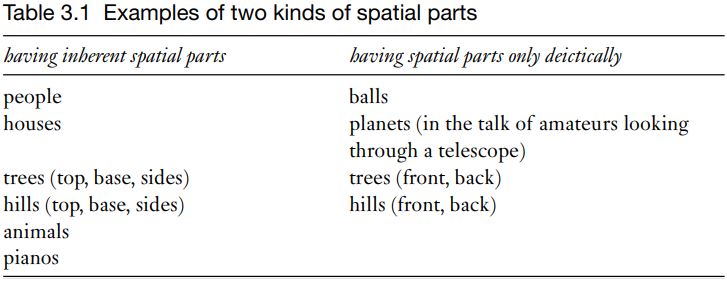

Grammar


Tenses


Present

Present Simple

Present Continuous

Present Perfect

Present Perfect Continuous


Past

Past Simple

Past Continuous

Past Perfect

Past Perfect Continuous


Future

Future Simple

Future Continuous

Future Perfect

Future Perfect Continuous


Parts Of Speech


Nouns

Countable and uncountable nouns

Verbal nouns

Singular and Plural nouns

Proper nouns

Nouns gender

Nouns definition

Concrete nouns

Abstract nouns

Common nouns

Collective nouns

Definition Of Nouns

Animate and Inanimate nouns

Nouns


Verbs

Stative and dynamic verbs

Finite and nonfinite verbs

To be verbs

Transitive and intransitive verbs

Auxiliary verbs

Modal verbs

Regular and irregular verbs

Action verbs

Verbs


Adverbs

Relative adverbs

Interrogative adverbs

Adverbs of time

Adverbs of place

Adverbs of reason

Adverbs of quantity

Adverbs of manner

Adverbs of frequency

Adverbs of affirmation

Adverbs


Adjectives

Quantitative adjective

Proper adjective

Possessive adjective

Numeral adjective

Interrogative adjective

Distributive adjective

Descriptive adjective

Demonstrative adjective


Pronouns

Subject pronoun

Relative pronoun

Reflexive pronoun

Reciprocal pronoun

Possessive pronoun

Personal pronoun

Interrogative pronoun

Indefinite pronoun

Emphatic pronoun

Distributive pronoun

Demonstrative pronoun

Pronouns


Pre Position


Preposition by function

Time preposition

Reason preposition

Possession preposition

Place preposition

Phrases preposition

Origin preposition

Measure preposition

Direction preposition

Contrast preposition

Agent preposition


Preposition by construction

Simple preposition

Phrase preposition

Double preposition

Compound preposition

prepositions


Conjunctions

Subordinating conjunction

Correlative conjunction

Coordinating conjunction

Conjunctive adverbs

conjunctions


Interjections

Express calling interjection

Phrases

Sentences


Grammar Rules

Passive and Active

Preference

Requests and offers

wishes

Be used to

Some and any

Could have done

Describing people

Giving advices

Possession

Comparative and superlative

Giving Reason

Making Suggestions

Apologizing

Forming questions

Since and for

Directions

Obligation

Adverbials

invitation

Articles

Imaginary condition

Zero conditional

First conditional

Second conditional

Third conditional

Reported speech

Demonstratives

Determiners


Linguistics

Phonetics

Phonology

Linguistics fields

Syntax

Morphology

Semantics

pragmatics

History

Writing

Grammar

Phonetics and Phonology

Semiotics


Reading Comprehension

Elementary

Intermediate

Advanced


Teaching Methods

Teaching Strategies

Assessment
Spatial parts
المؤلف:
Patrick Griffiths
المصدر:
An Introduction to English Semantics And Pragmatics
الجزء والصفحة:
44-3
12-2-2022
1243
Spatial parts
A prototype thing, such as a rock, can be said to have a top, a bottom (or base), sides and a front and back. Two points need to be noted about these words. One is that they are general: very many different kinds of thing – windows, heads, faces, feet, buses, trees, canyons, to randomly name just a few – have tops, bottoms, sides, fronts and backs. In Section 3.2 this will be explained in terms of a thing having spatial parts, making the possession of such parts characteristic of prototypes in the thing-category. The other notable feature of spatial part words is that they are often deictic.
Pragmatics enters the interpretation of deictic words. As explained, the meaning of a deictic word is tied to the situation of utterance. The front of a rock faces the speaker and the back of a rock faces away from the speaker, and the sides are to the left and right from the point of view of the speaker. What counts as the top of the rock and what counts as the bottom or base of the rock depends on which way up the rock happens to be lying at the time of utterance. However, many things – bus is a good example – inherently have a non-deictic top, bottom, front and back, and sides. The top of a bus is its roof, even in the dire case of one lying overturned at the side of the road; the front of a bus is the driver’s end of it, regardless of where the speaker is viewing it from; and so on. It is with things that do not inherently have these parts that the deictic top, bottom, front, back and sides come into play. Notice that a rescue worker who is standing “on top” (as one might say deictically) of an overturned bus is not on the top (part) of the bus. The list in Table 3.1 gives further examples.

There are additional subtleties that would have to be dealt with in a fuller account. For instance, it is possible to cede deictic centrality to someone being addressed, as when – speaking from behind a tree – a person says: “Just open your eyes and you’ll see the notice: (from where you are) it’s pinned on the front of the tree.”
 الاكثر قراءة في Semantics
الاكثر قراءة في Semantics
 اخر الاخبار
اخر الاخبار
اخبار العتبة العباسية المقدسة

الآخبار الصحية















 قسم الشؤون الفكرية يصدر كتاباً يوثق تاريخ السدانة في العتبة العباسية المقدسة
قسم الشؤون الفكرية يصدر كتاباً يوثق تاريخ السدانة في العتبة العباسية المقدسة "المهمة".. إصدار قصصي يوثّق القصص الفائزة في مسابقة فتوى الدفاع المقدسة للقصة القصيرة
"المهمة".. إصدار قصصي يوثّق القصص الفائزة في مسابقة فتوى الدفاع المقدسة للقصة القصيرة (نوافذ).. إصدار أدبي يوثق القصص الفائزة في مسابقة الإمام العسكري (عليه السلام)
(نوافذ).. إصدار أدبي يوثق القصص الفائزة في مسابقة الإمام العسكري (عليه السلام)


















